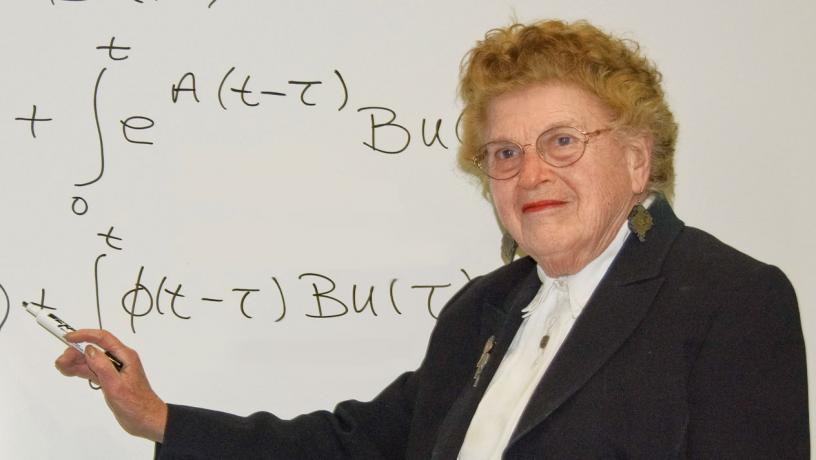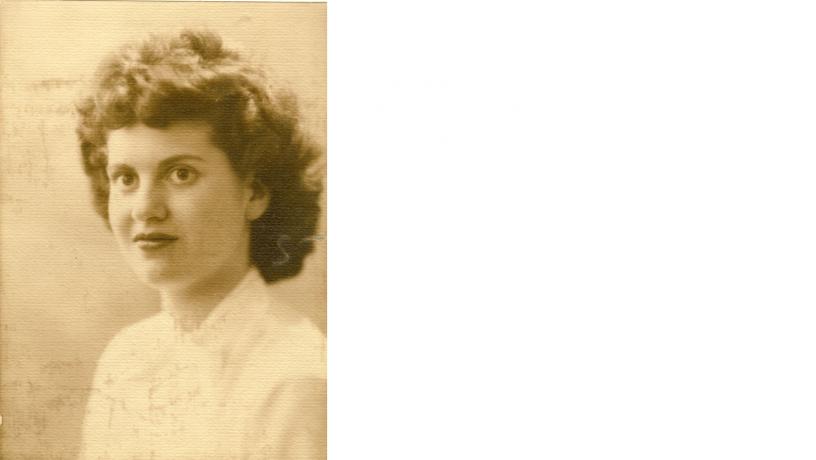Columbia Engineering Says Goodbye to First Female Graduate Gloria Reinish

Columbia Engineering mourns the passing of alumna Gloria Brooks Reinish (BS ’45, MS ’48, EngScD ’74). As the first woman to obtain a degree from the engineering school, Reinish paved the way for women in technical professions in industry and academia throughout a successful career as a patent-holding engineer, researcher, professor, and mentor. Over the course of her long career, her pioneering approach also anticipated the multidisciplinary direction engineering would take in the 20th century.
Born in Brooklyn on July 23, 1925, Reinish was the only child of Celia and Julius Brooks. A love of math and the influence of a high school friend prompted her to apply for the tuition-free engineering program at Cooper Union. After two years at Cooper Union, she received a scholarship to attend Columbia Engineering in 1943, the same year the engineering school began accepting women. She was the only woman in the engineering program and the first to graduate in 1945, with a BS in electrical engineering. She was second in her class.
After graduation, Reinish applied her degree in industry, at first refusing an employment offer from Bell Labs because she would be hired as a “technical assistant” and not a “member of technical staff” like the new male employees. Bell Labs relented, and Reinish began working on radar systems. After Bell Labs, she moved to Sperry Gyroscope, a major equipment and electronics company. It was at Sperry that Reinish would work on a project that led to her patent on a radar ranging system. Also while at Sperry, Reinish began studying for her Master’s degree at Columbia Engineering, travelling between her home in Brooklyn’s Manhattan Beach to Sperry’s offices in Long Island to Columbia in Upper Manhattan.
In 1948, she completed her Master’s in electrical engineering and married a fellow engineer. Reinish took time off in 1951 to care for her growing family, but soon felt the pull of engineering calling her back. After her family’s move to New Jersey, she began substitute teaching physics and math in local schools. When compiling the information she needed for certification as a substitute teacher, Reinish had the idea to inquire into teaching opportunities at nearby Fairleigh Dickinson University. The school hired her immediately at mid-semester to start teaching night classes in electronics.
Her love of teaching college students motivated Reinish to pursue her doctorate, again at Columbia. An alumni event featuring a professor in the nascent area of bioengineering encouraged her to pursue her degree in that emerging field. She spent the next several years attending classes at Columbia four days a week, teaching at Fairleigh Dickinson, and taking care of her family. She completed her degree in 1974 and became a full professor at Fairleigh Dickinson.
Reinish was at the forefront of advances in engineering that were pushing the field in a more multidisciplinary direction. A seminar by the head of orthopedic research at Columbia’s College of Physicians and Surgeons sparked her interest in the electrical properties of bone as a thesis subject, one that could draw on her background in electrical engineering. At the time, bioengineering was made up mostly of chemical engineers, physicians, and physiologists. Bringing an electrical engineering perspective was a new approach, which made finding a thesis advisor a challenge. She eventually found Professor Arthur Nowick, an expert in materials science, who contributed his own area of knowledge to the subject. Her resulting thesis investigated how electricity could stimulate bone growth in humans in response to stress. For her work, she was later appointed as a consultant to the FDA on a panel to approve medical devices that could knit bones together more quickly through electrical stimulation.

Gloria Reinish in 1943, when she
enrolled at Columbia Engineering.
When Columbia Engineering celebrated its 150th anniversary in 2014, the School took a look back at the lives and experiences of SEAS alumni and faculty. This video features Gloria Reinish.
Reinish had an illustrious teaching career at Fairleigh Dickinson, rising to become the first woman to chair the Electrical Engineering Department and founding chair of its bioengineering program. She also pioneered the development of online education programs for engineering and started the first chapter of Society of Women Engineers, reflecting a lifelong dedication to promoting women in the field.
Her passion for engineering also inspired a family tradition. All three of her children grew up to be engineers, and her son (Jim Reinish, BS '82), daughter (Nancy Passow, BS '72), and grandchild (Ariel Reinish, BS 2010) all went to Columbia Engineering. Daughter Julie Askins graduated with an engineering degree from Princeton in 1977 and, in another first, Reinish and her daughter Nancy were Columbia students at the same time in the 1970’s.
Among her honors, she was a life member of IEEE, a Fellow of the Society of Women Engineers, and was listed in 2007-2012 Marquis "Who's Who in America.” She also enjoyed tennis, golf, ice skating, and playing the piano.
